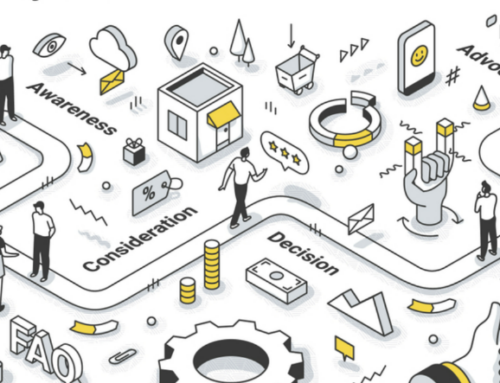One thing which is common for businesses of any size (and all industries) is that customers always like to be treated like Kings.
And banking customers are no different.
Banking customers – besides having a great product or services – expect great customer support and aftersales nurturing which leverage customers’ expectations on a completely different level.
Today, taking care of your customer needs takes on the most important significance and if neglected, a customer can not only take his business to a competitor but also harm the bank’s brand image through negative word of mouth which can lead to a higher churn rate.
The truth: Your customers don’t care about channels
Everyone talks about channels.
The e-commerce channel, the branch, the mobile app channel, and on and on.
Maybe this was an interesting distinction 7-10 years ago when the multi-channel approach was a hot topic, but for many years now the distinction between channels has been evaporating as we no longer go online over one specific channel, we live online over many different channels.
Today, some sort of smart device – like mobile or tablet – has become a constant companion in today’s banking customers’ journeys everywhere from the branch as a brick mortal point of contact where we need our device to start the journey, to the social networks and chatbots where we ask for support.
The ultimate result is that customers can go back and forth between a digital channel(s) and a physical channel at any time they would like in a fully seamless way and without taking care about channels.
Omnichannel vs omnirelevant?
The problem for far too many banks is that they are still stuck in their channel-centric thinking and their organizations, metrics, and internal systems development, which customers don’t really care about.
What customers do care about is being relevant and accessible at any time they need you.
From a bank perspective, being everywhere the customer sounds like a really good digital bank/omnichannel strategy.
But the omnichannel game is not about ‘having it all.
It is about being relevant, agile, and remarkable where it really matters for your customers.
Too many banks took the “omnichannel” to the extreme, and in the need to be everywhere they mostly ended up being nowhere from the customer perspective.
Meeting the consumers where they really are and actually being good at serving them in a way they expect is neither easy nor inexpensive and demands great technology to support processes.
How to approach the omnichannel strategy?
For both sides – customers and banks – it is far better to focus on delivering a harmonized user experience rather than trying to be everywhere.
By this, we mean focusing on eliminating the unnecessary stages of the process and improving the “wow effect” in the customer journeys for those customers that have the greatest current and future lifetime value.
In practice, it means for the bank to be fully reachable for customers at any time and having unified communication without frustrating a customer and asking him to repeat the steps he already did on another channel no matter if the journey started offline or online.
3 key omnichannel metrics to follow
As we stated above, the ultimate goal is to have harmonized communication with your customers and in order to do so here are Top3 metrics you should follow:
- Time to resolution: Being able to resolve issues quickly and efficiently is what makes a “wow” effect. By enabling your customer to address the problem online, you get to the point much faster, eliminating any unnecessary stages in the process. Squeezing time to resolution % will make your customer happier and more comfortable with your bank.
- Fully personalized service: For banking customers, omnichannel isn’t just about improved efficiency and time to resolution metrics but also communicating with the bank in more personalized service. This means that customers expect flexibility in adapting to their needs, rather than adopting a one-size-fits-all approach.
- Higher customer lifetime value: Banks that have implemented omnichannel in a way that customers can enjoy both a faster and more personalized service experience improved loyalty, thus resulting in a higher CLV.
The omnichannel dilemmas
Even banks that do a superb job of focusing their omnichannel implementation strategically can still face challenges while trying to implement a harmonious user experience.
This can lead to significant costs and even losing customers due to frustrating user experience.
That is why we would like to underline Top2 common dilemmas:
- Conflict between channels
This is #1 dilemma that every bank implementing omnichannel strategy has. All the banks nowadays have a lot of channels such as email, SMS, Viber and many more, and the more the channels, the more the challenges they are facing. The solution here lies in the data you have. The bank should create a centralized data warehouse and a plan that can predict customer journey in order to overcome potential channel conflicts.
- Which channels do your customers really need?
Again “the secret” here lies in the data you have and your ideal customer profile. The truth is that customers always go down their unique paths and in order to map their journey with your omnichannel strategy you will need to gather all the data you have and analyze the patterns in order to create your omnichannel marketing strategy through all sources, such as in-store, website, browsing behavior, app, email marketing campaigns, landing page conversions, and so on.
Recap
The fact is that the banking industry – in many cases – still lacks a useful definition of what “omnichannel” really means. The reason for that is because many banks embarked on a “get me some of that omnichannel stuff” and spread themselves way too thin without having a proper omnichannel strategy.
All of this led to too many omnichannel options implemented without being properly harmonized for a good end customer experience.
And the truth is that customers are not ready to accept a ‘one size fits all’ treatment anymore.
What Customers really want is their individual preferences to be noticed and respected in a fully personalized way, over the channel they prefer.
Having a solid multichannel infrastructure and providing an omnichannel experience allows customers to enjoy seamless ways and this is what should be a core foundation of a proper omnichannel and digital bank strategy – a personalized 24/7 service across every touchpoint your customer really needs.
Wondering how to start? Ask the experts:
ASEE is a digital banking solution provider with vast experience in implementing different solutions in banks of various sizes and markets. For a free consulting call or more information get in touch.






